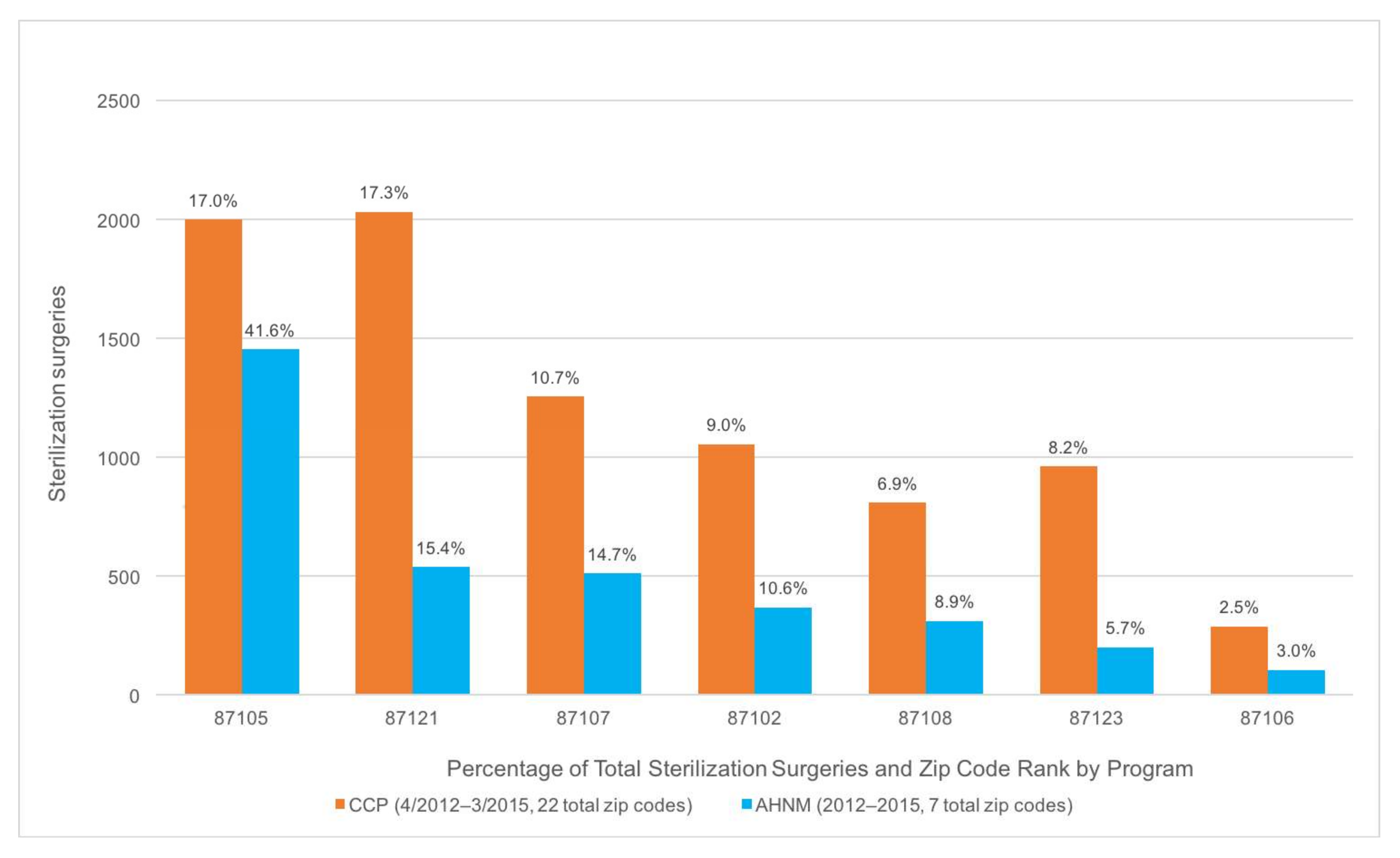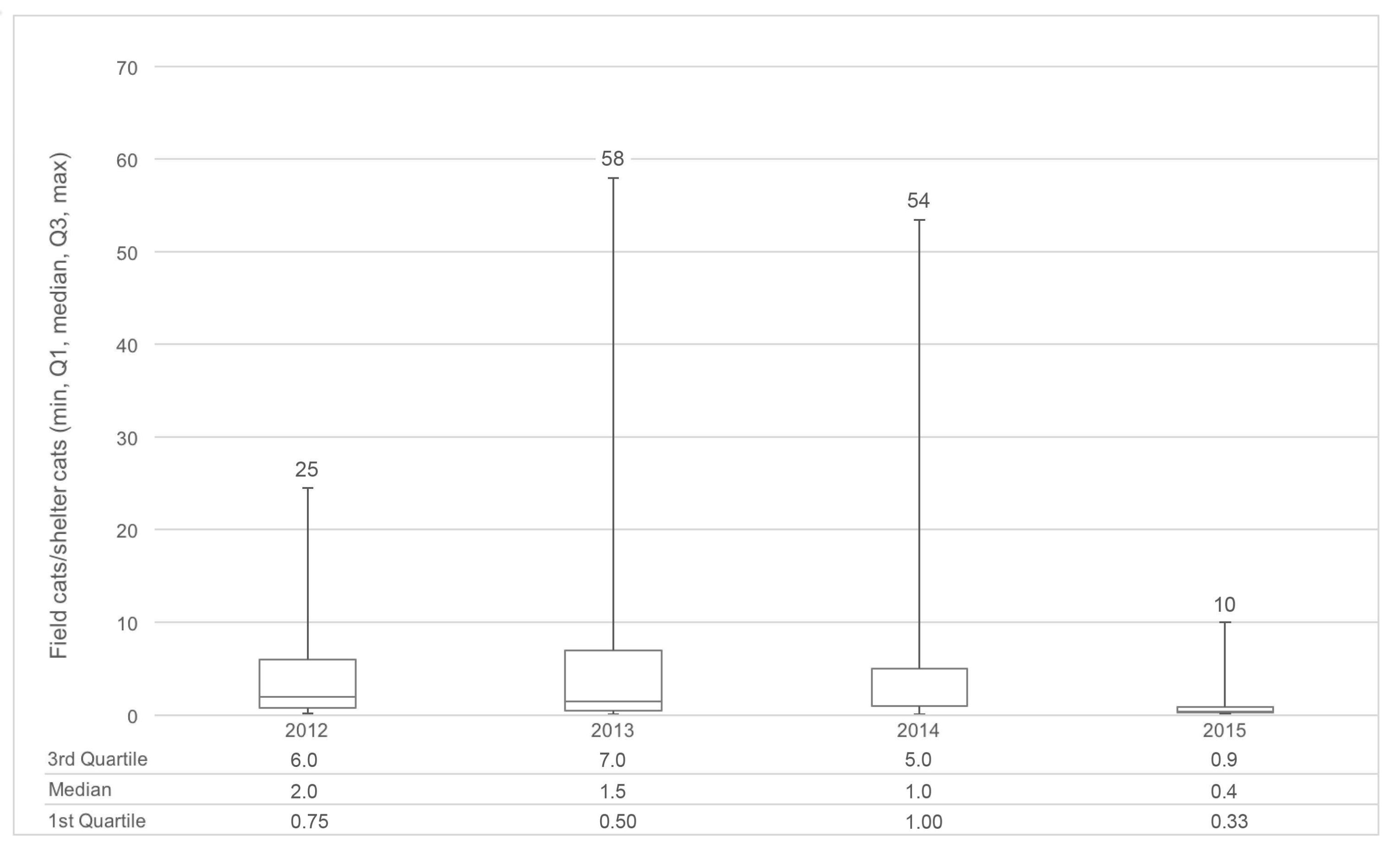The Impact of an Integrated Program of Return-to-Field and Targeted Trap-Neuter-Return on Feline Intake and Euthanasia at a Municipal Animal Shelter
Abstract
:Simple Summary
Abstract
1. Introduction
1.1. Feline Intake and Euthanasia Trends at U.S. Animal Shelters: A Historical Perspective
1.2. Site Description and Lead-Up to the Initiation of the Community Cat Program
2. Materials and Methods
2.1. The Albuquerque Animal Welfare Department’s Community Cat Program: Integrating the Use of Return-to-Field and Targeted Trap-Neuter-Return (TNR)
2.2. Data Collection
2.3. Data Analysis
3. Results
4. Discussion
5. Study Limitations
6. Conclusions
Acknowledgments
Author Contributions
Conflicts of Interest
References
- Clancy, E.A.; Rowan, A.N. Companion Animal Demographics in the United States: A Historical Perspective. In The state of the animals II; Salem, D.J., Rowan, A.N., Eds.; Humane Society Press: Washington, DC, USA, 2003; pp. 9–26. [Google Scholar]
- Rowan, A.N. Cat demographic analyses in the USA. In 2013 National Council on Pet Population Research Symposium Presentations: CATS: The Ins and Outs: Improving their Future Through Research; Society of Animal Welfare Administrators: Tempe, AZ, USA, 2013. [Google Scholar]
- Zawistowkski, S.; Morris, J.; Salman, M.D.; Ruch-Gallie, R. Population Dynamics, Overpopulation, and the Welfare of Companion Animals: New Insights on Old and New Data. J. Appl. Anim. Welf. Sci. 1998, 1, 193–206. [Google Scholar] [CrossRef] [PubMed]
- Bartlett, P.C.; Bartlett, A.; Walshaw, S.; Halstead, S. Rates of Euthanasia and Adoption for Dogs and Cats in Michigan Animal Shelters. J. Appl. Anim. Welf. Sci. 2005, 8, 97–104. [Google Scholar] [CrossRef] [PubMed]
- Cicirelli, J. Managing Shelter Cat-astrophe. In The Outdoor Cat: Science and Policy from a Global Perspective; The Humane Society Institute for Science and Policy: Marina del Ray, CA, USA, 2012. [Google Scholar]
- Gilbreath, A. Cats in Los Angeles. In The Outdoor Cat: Science and Policy from a Global Perspective; The Humane Society Institute for Science and Policy: Marina del Ray, CA, USA, 2012. [Google Scholar]
- Johnson, K.L.; Cicirelli, J. Study of the effect on shelter cat intakes and euthanasia from a shelter neuter return project of 10,080 cats from March 2010 to June 2014. PeerJ 2014, 2, e646. [Google Scholar] [CrossRef] [PubMed]
- Humane Society of the United States. Pets by the Numbers. Available online: https://www.animalsheltering.org/page/pets-by-the-numbers (accessed on 22 November 2017).
- Levy, J.K.; Woods, J.E.; Turick, S.L.; Etheridge, D.L. Number of unowned free-roaming cats in a college community in the southern United States and characteristics of community residents who feed them. J. Am. Vet. Med. Assoc. 2003, 223, 202–205. [Google Scholar] [CrossRef] [PubMed]
- Levy, J.K.; Isaza, N.M.; Scott, K.C. Effect of high-impact targeted trap-neuter-return and adoption of community cats on cat intake to a shelter. Vet. J. 2014, 201, 269–274. [Google Scholar] [CrossRef] [PubMed]
- Hurley, K.F.; Levy, J.K. New Paradigms for Shelters and Community Cats. Available online: https://vetmed-maddie.sites.medinfo.ufl.edu/files/2014/07/New-Paradigms-for-Shelters-and-Community-Cats.pdf (accessed on 16 May 2016).
- Alley Cat Allies. Cat Fatalities and Secrecy in U.S. Pounds and Shelters. Available online: https://www.alleycat.org/resources/cat-fatalities-and-secrecy-in-u-s-pounds-and-shelters/ (accessed on 22 November 2017).
- White, S.C.; Jefferson, E.; Levy, J.K. Impact of Publicly Sponsored Neutering Programs on Animal Population Dynamics at Animal Shelters: The New Hampshire and Austin Experiences. J. Appl. Anim. Welf. Sci. 2010, 13, 191–212. [Google Scholar] [CrossRef] [PubMed]
- Morris, K.N.; Gies, D.L. Trends in Intake and Outcome Data for Animal Shelters in a Large U.S. Metropolitan Area, 1989 to 2010. J. Appl. Anim. Welf. Sci. 2014, 17, 59–72. [Google Scholar] [CrossRef] [PubMed]
- Scarlett, J.; Johnston, N. Impact of a Subsidized Spay Neuter Clinic on Impoundments and Euthanasia in a Community Shelter and on Service and Complaint Calls to Animal Control. J. Appl. Anim. Welf. Sci. 2012, 15, 53–69. [Google Scholar] [CrossRef] [PubMed]
- Lord, L.K.; Wittum, T.E.; Ferketich, A.K.; Funk, J.A.; Rajala-Schultz, P.; Kauffman, R.M. Demographic trends for animal care and control agencies in Ohio from 1996 to 2004. J. Am. Vet. Med. Assoc. 2006, 229, 48–54. [Google Scholar] [CrossRef] [PubMed]
- American Society for the Prevention of Cruelty to Animals. Pet Statistics. Available online: https://www.aspca.org/animal-homelessness/shelter-intake-and-surrender/pet-statistics (accessed on 22 November 2017).
- Kortis, B. Community TNR: Tactics and Tools; PetSmart Charities, Inc.: Phoenix, AZ, USA, 2014; ISBN 978-1-49-759016-8. [Google Scholar]
- World Atlas. Where is Albuquerque, NM? Available online: http://www.worldatlas.com/na/us/nm/where-is-albuquerque.html (accessed on 22 November 2017).
- U.S. Census. U.S. Census Bureau QuickFacts: Albuquerque city, New Mexico. Available online: https://www.census.gov/quickfacts/fact/table/albuquerquecitynewmexico/PST045216 (accessed on 22 November 2017).
- U.S. Census. U.S. Census Bureau QuickFacts: Bernalillo County, New Mexico. Available online: https://www.census.gov/quickfacts/fact/map/bernalillocountynewmexico/PST045216#viewtop (accessed on 22 November 2017).
- All Shelters Are Not Alike--The Important Differences That Can Affect the Mission. The Humane Society of the United States Shelter Advocate Toolkit. Available online: http://www.humanesociety.org/assets/pdf/pets/shelter-advocate-toolkit/all_shelters_are_not_alike_.pdf (accessed on 24 November 2017).
- City of Albuquerque Animal Shelters & Services—City of Albuquerque. Available online: https://www.cabq.gov/pets/shelters-rescue-groups/animal-shelters-services (accessed on 22 November 2017).
- Bruin, B.; Formerly of Albuquerque Animal Welfare Department, Albuquerque, NM, USA. Personal communication, 13 November 2017.
- City of Albuquerque Humane and Ethical Animal Rules and Treatment; Vol. O-2006-029; Part 3, Subsection 9-2-3-1: Required Albuquerque Companion Animal License. Available online: http://www.cabq.gov/pets/education-resources/heart-ordinance/heart-ordinance-text (accessed on 14 January 2018).
- Ludwick, J. Street Cat Program Paves the Way for Breathtaking Improvements; AAWD: Albuquerque, NM, USA, 2017; pp. 3–4. [Google Scholar]
- Bruin, B. Trap/Neuter/Return (TNR): A Bold Initiative That Produced Results. Available online: http://www.barbarabruin.com/trapneuterreturn-tnr-a-bold-initiative-that-produced-results/ (accessed on 22 November 2017).
- Ludwick, J.; Albuquerque Animal Welfare Department, Albuquerque, NM, USA. Personal communication, 13 December 2016.
- Sage, J.; Street Cat Hub, Albuquerque, NM, USA. Personal communication, 5 December 2017.
- Kortis, B.; Vana, H. Saving Albuquerque’s Community Cats. Available online: https://www.petsmartcharities.org/grant-stories/saving-albuquerque-s-community-cats (accessed on 22 November 2017).
- Triste-Aragon, D.; Best Friends Animal Society, Kanab, UT, USA. Personal communication, 9 December 2016.
- Sage, J.; Street Cat Hub, Albuquerque, NM, USA. Personal communication, 8 April 2017.
- Triste-Aragon, D.; Best Friends Animal Society, Kanab, UT, USA. Personal communication, 16 January 2018.
- Crowe, A.; Best Friends Animal Society, Kanab, UT, USA. Personal communication, 8 January 2018.
- Bruin, B.; Formerly of Albuquerque Animal Welfare Department, Albuquerque, NM, USA. Personal communication, 9 January 2018.
- American Society for the Prevention of Cruelty to Animals. What is your Rate? Understanding the Asilomar Live Release Rate, ASPCA Live Release Rate and Save Rate. Available online: http://www.aspca.org/sites/pro/files/ (accessed on 14 January 2018).
- Houser, S.; Jacksonville, F.L. Front Door Writ. Anim. Shelter. U.S. Available online: http://www.outthefrontdoor.com/2015/10/19/jacksonville-update/ (accessed on 6 January 2018).
- Zito, S.; Paterson, M.; Morton, J.; Vanken, D.; Bennett, P.; Rand, J.; Phillips, C.J.C. Surrenderers’ Relationships with Cats Admitted to four Australian Animal Shelters. Animals 2018, 8, 23. [Google Scholar] [CrossRef] [PubMed]
- Albuquerque population―Google Search. Available online: https://www.google.com/search?ei=-f1cWuajCNuwjAOh1pzYAg&q=albuquerque+population&oq=albuquerque+population&gs_l=psy-ab.3..0l10.2460.11070.0.12004.37.28.0.0.0.0.295.3508.0j20j2.23.0....0...1.1.64.psy-ab..14.23.3727.6..0i67k1j0i22i30k1j0i22i10i30k1j35i39k1j0i131k1j0i20i264k1j0i131i67k1j0i131i20i263k1.223.e13MlFodGmI (accessed on 15 January 2018).
- Webb, E.; Animal Humane New Mexico, Albuquerque, NM, USA. Personal communication, 30 November 2017.
- Crowe, A.; Best Friends Animal Society, Kanab, UT, USA. Personal communication, 13 August 2017.
- Edinboro, C.H.; Watson, H.N.; Fairbrother, A. Association between a shelter-neuter-return program and cat health at a large municipal animal shelter. J. Am. Vet. Med. Assoc. 2016, 248, 298–308. [Google Scholar] [CrossRef] [PubMed]
- Weiss, E.; Slater, M.; Lord, L. Frequency of Lost Dogs and Cats in the United States and the Methods Used to Locate Them. Animals 2012, 2, 301–315. [Google Scholar] [CrossRef] [PubMed]
- Bruin, B.; Formerly of Albuquerque Animal Welfare Department, Albuquerque, NM, USA. Personal communication, 8 December 2017.
- Spehar, D.D.; Wolf, P.J. A Case Study in Citizen Science: The Effectiveness of a Trap-Neuter-Return Program in a Chicago Neighborhood. Animals 2018, 8, 14. [Google Scholar] [CrossRef] [PubMed]




| Mode of Disposition | Total Cats | Percentage |
|---|---|---|
| Returned to Colony | 10,738 | 91.42 |
| Adopted/Rescue | 946 | 8.05 |
| Died | 34 | 0.29 |
| Euthanized | 20 | 0.17 |
| Relocated | 6 | 0.05 |
| Other | 2 | 0.02 |
| Totals | 11,746 | 100 |
| Shelter Metric | Age Classification | Before Program | After Program |
|---|---|---|---|
| Overall feline intake * | 9776 | 6102 | |
| Kittens ** | 4441 | 2468 | |
| <2 months old ** | 2803 | 1672 | |
| Overall feline euthanasia * | 3023 | 480 | |
| Kittens ** | 1462 | 149 | |
| Feline euthanasia rate * | 30.9% | 7.9% | |
| Kittens ** | 32.9% | 6.0% | |
| Feline LRR ** | 60.6% | 89.5% | |
| Adoptions ** | 4264 | 3333 | |
| Adoptions/feline intake ** | 43.5% | 60.2% | |
| RTO (returned to owner) ** | 297 | 277 | |
| RTO/feline intake ** | 3.0% | 5.0% | |
| Calls for dead cat pick-up ** | 2220 | 1689 |
| Category and Period of Interest | Community | ||
|---|---|---|---|
| Albuquerque/Bernalillo County, NM | San José, CA | Alachua County, FL (zip code 32601) | |
| Type of program(s) | Targeted TNR & RTF | RTF | Targeted TNR |
| Program duration | 3 years | 4 years | 2 years |
| Feline intake/1000 human population | |||
| Before program | 14.7 | 10.2 | 13.0 |
| After program | 8.2 | 7.0 | 4.0 |
| Reduction | 44.2% | 31.4% | 69.2% |
| Euthanasia/1000 human population | |||
| Before program | 5.2 | 7.2 | 8.0 |
| After program | 0.7 | 1.6 | 0.4 |
| Reduction | 86.5% | 77.8% | 95.0% |
| Average sterilizations annually/1000 human population | 5.4 | 2.7 | 60.5 |
| Source of data | This study | [5] | [10] |
© 2018 by the authors. Licensee MDPI, Basel, Switzerland. This article is an open access article distributed under the terms and conditions of the Creative Commons Attribution (CC BY) license (http://creativecommons.org/licenses/by/4.0/).
Share and Cite
Spehar, D.D.; Wolf, P.J. The Impact of an Integrated Program of Return-to-Field and Targeted Trap-Neuter-Return on Feline Intake and Euthanasia at a Municipal Animal Shelter. Animals 2018, 8, 55. https://doi.org/10.3390/ani8040055
Spehar DD, Wolf PJ. The Impact of an Integrated Program of Return-to-Field and Targeted Trap-Neuter-Return on Feline Intake and Euthanasia at a Municipal Animal Shelter. Animals. 2018; 8(4):55. https://doi.org/10.3390/ani8040055
Chicago/Turabian StyleSpehar, Daniel D., and Peter J. Wolf. 2018. "The Impact of an Integrated Program of Return-to-Field and Targeted Trap-Neuter-Return on Feline Intake and Euthanasia at a Municipal Animal Shelter" Animals 8, no. 4: 55. https://doi.org/10.3390/ani8040055




